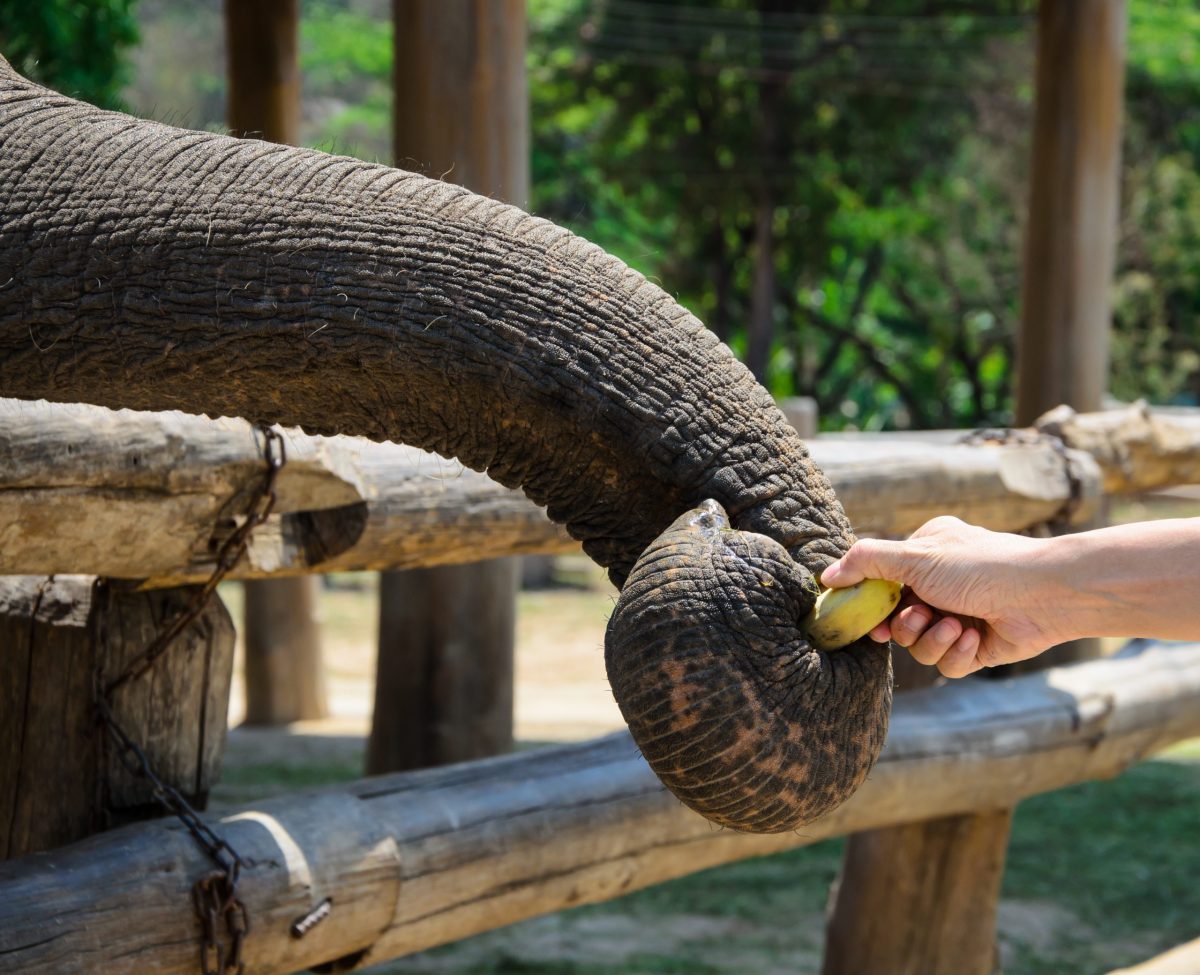Can Elephants Learn By Observing and Imitating Others?
Posted on Categories Discover Magazine

Elephants love eating bananas, and feast on them whole whenever they can. But Pang Pha, a 36-year-old Asian elephant who lives at the Berlin Zoo, is a little more precious: she happens to prefer her bananas peeled.
While growing up, Pha was under the custody of an attentive caretaker who used to peel her bananas for her. Now, she seems to have taught herself to break the banana against her trunk and wriggle the insides of the fruit from its peel, discarding the latter and savoring just the pulp.
Pha’s story is detailed in a recent elephant study in Current Biology, which suggests her behavior could be an example of an animal learning from copying somebody else’s behavior — in this case, her caretaker. Some critics, however, argue it’s just an example of learning through trial and error instead.
Either way, Pha’s experience has re-ignited discussions about whether or not elephants can learn by observing others — and what we know about their potential for mimicry.
How Pang Pha Learned to Peel Bananas
Pha not only learned to peel bananas herself; she also peeled them with extreme dexterity, says study author Michael Brecht, a professor at Humboldt-Universität zu Berlin who researches elephants’ grasping trunk behaviors.
“She developed a very impressive peeling algorithm, you know, she’s faster than humans, about three times faster,” says Brecht. “And that’s quite something because we have two hands, right? She has just one trunk.”
Pha is far from the only elephant to ever peel bananas. But while there are other examples, says Brecht, it does seem quite rare as a behavior. Although there is no rock-solid proof she learned to peel her bananas from observation learning, the evidence is indeed “very suggestive” of this, he adds, arguing that this is an example of acquired experience-dependent behaviors.
However, it’s not the case that learning through observation “spreads like a bushfire” among elephants, says Brecht. It’s just humans that copy like crazy, he adds.
Is Elephant Behavior Really Mimicry?
Moti Nissani, a professor emeritus of interdisciplinary studies at Michigan’s Wayne State University who has researched elephant cognition, argues that Pang’s companions should be learning the trick, too, if her banana peeling is an example of mimicry.
“It is entirely possible that at one point or another, Pang Pha was not that hungry, and she randomly played with a banana and managed to accidentally peel it,” Nissani says. “Peeled bananas clearly are far better, as we ourselves know, than whole bananas, so she gradually learned the trick.”
This observation is suggestive, but a far cry from lending support for mimicry or the implied theory of mind as the explanatory mechanism, he says. (Similar to the case of a Japanese macaque monkey named Imo, who washed her potatoes in a nearby river to rid them of sand.) Behaviors such as these raise the possibility that whatever mimicry takes place in this species is not based on theory of mind, but a process that is more akin to trial-and-error learning.
Can Elephants Learn from Observing and Imitating Others?
It is certainly possible Pang Pha learned to peel the banana on her own, says Joshua Plotnik, a comparative psychologist at Hunter College, CUNY in New York. But, in general, yes, elephants do socially learn from others.
“This is a common way social animals learn from others within their social group,” says Plotnik. “Much of this learning is from observations of others.”
Elephants may even be able to mimic humans in other ways, too. Although there isn’t much experimental work on social learning in elephants, Plotnik points to a 2012 study as an example of vocal learning in elephants, in which researchers documented an elephant living in a zoo in South Korea who learned to imitate human speech. And over a decade prior, a study published in Nature in 2005 described how African savannah elephants are capable of vocal learning, paving the way for research into this realm.
Read More: Elephants Now Gang Up In Human-Dominated Areas
Do Elephants Learn Through Mimicry?
Still, the debate is far from settled. According to Professor Richard William Byrne, who studies the evolution of cognitive and social behavior at St. Andrews University in Scotland, Pang Pha would have naturally discovered how to peel her bananas by exploration. What’s more, it’s no surprise for a rather intelligent animal like an elephant to learn things in this manner.
In fact, there are lots of reasons to think that elephants can (and do) learn socially, acquiring knowledge from being in a social setting. But since the direct evidence for this is pretty scarce, it’s really hard for scientists to know for sure.
Much of our lack of knowledge on elephant cognition lies in how hard it is to study elephants in the first place, says Byrne. Because of how gigantic they are — and how unhappy they tend to be when in confined environments — elephants are much harder to examine than, say, chimpanzees sitting in a zoo or a rat in a lab.
“But we don’t really know much about what they learn by observation,” adds Byrne, and observational learning is one of the hardest things to research. At the very least, he continues, we do know that elephants take account of those around them.
Read More: Human Activities Affect Elephants’ Use of Nature Preserves